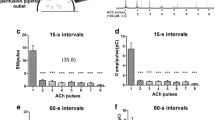Abstract
Three classes of agonists, associated with Ca2+-mobilization — α1-adrenergic (methoxamine), muscarinic (carbachol) and peptidergic (substance P, SP) — significantly stimulated the secretion of mucin from enzymatically-dispersed rat submandibular gland acinar cells. The same three secretagogues also caused the hydrolysis of membrane inositol phospholipids, resulting in elevated cellular levels of inositol phosphates, particularly inositol 1,4,5-trisphosphate (IP3). Exogenous IP3 elicited the dose-dependent release of mucin in dispersed cells suggesting that agonist-generated endogenous IP3 may provoke a secretory response. IP3 and the phorbol ester 12-O-tetradecanoylphorbol-13-acetate (TPA) in combination, stimulated an additive secretion of mucin in the model. The potential use of these two agents as specific probes of the IP3- and diacylglycerol-associated legs of the polyphosphoinositide (PPI) breakdown pathway is indicated. Although all three agonists shared a common action in stimulating PPI hydrolysis, their effects on the β-adrenergic mucosecretory response were inconsistent. A brief preincubation of cells with carbachol or SP significantly reduced the subsequent isoproterenol (IPR)-provoked secretion of mucin, whereas methoxamine plus IPR stimulated an additive response. The mechanisms underlying these opposite effects are not known. Failure of IP3 or TPA to modify IPR responses suggests that modulation of the β response may operate at a locus before the generation of diacylglycerol and IP3, possibily at the level of signal transduction. The study indicates a role for Ca2+-mobilizing, agonists in controlling submandibular mucin secretion and provides evidence that receptor-linked phosphoinositide hydrolysis is an early stage in their stimulus-secretion coupling mechanism.
Similar content being viewed by others
References
Berridge MJ (1983) Rapid accumulation of inositol trisphosphate reveals that agonists hydrolyse polyphosphoinositides instead of phosphatidylinositol. Biochem J 212:849–858
Berridge MJ (1984) Inositol trisphosphate and diacylglycerol as second messengers. Biochem J 220:345–360
Biden TJ, Prentki M, Irvine RF, Berridge MJ, Wollheim CB (1984) Inositol 1,4,5-trisphosphate mobilizes intracellular Ca2+ from permeabilized insulin-secreting cells. Biochem J 223:467–473
Bligh EG, Dyer WJ (1959) A rapid method of total lipid extraction and purification. Can J Biochem Physiol 37:911–917
Bogart BI, Picarelli J (1978) Agonist-induced secretions and potassium release from rat submandibular gland slices. Am J Physiol 235:C256-C268
Chandra Sekar M, Hokin LE (1986) The role of phosphoinositides in signal transduction. J Membr Biol 89:193–210
Downes CP, Wusteman MW (1983) Breakdown of polyphosphoinositides and not phosphatidylinositol accounts for agonist-stimulated inositol phospholipid metabolism in rat parotid glands. Biochem J 216:633–640
Farese RV, Larson RE, Sabir MA (1982) Ca2+-dependent and Ca2+-independent mechanisms for phosphatidylinositol hydrolysis and32P-labelling during cholinergic stimulation of the rat submaxillary gland in vitro. Arch Biochem Biophys 219:204–208
Farese RV, Orchard JL, Larson RE, Sabir MA, Davis JS (1985) Phosphatidylinositol hydrolysis and phosphtidylinositol 4,5-diphosphate hydrolysis are separable responses during secretagogue action in the rat pancreas. Biochim Biophys Acta 846:296–304
Fleming N, Bilan PT, Graham KW (1984) Effect of substance P on exocrine secretion by rat submandibular gland cells. J Dent Res 63:1022–1027
Fleming N, Bilan PT, Sliwinski-Lis E (1986) Effects of a phorbol ester and diacylglycerols on secretion of mucin and arginine esterase by rat submandibular gland cells. Pflügers Arch 406:6–11
Hokin MR (1974) Breakdown of phosphatidylinositol in the pancreas in response to pancreaozymin and acetylcholine. In: Thorn NA, Petersen OH (eds) Secretory mechanisms of exocrine glands. Munksgaard, Copenhagen, pp 101–112
Irvine RF, Letcher AJ, Lander DJ, Downes CP (1984) Inositol trisphosphates in carbachol-stimulated rat parotid glands. Biochem J 223:237–243
Irvine RF, Letcher AJ, Heslop JP, Berridge MJ (1986) The inositol tris/tetrakisphosphate pathway — demonstration of Ins (1,4,5)P3 3-kinase activity in animal tissues. Nature 320:631–634
Leslie BA, Putney JW, Sherman JM (1976) α-adrenergic, β-adrenergic and cholinergic mechanisms for amylase secretion by rat parotid glands in vitro. J Physiol (Lond) 260:351–370
Martinez JR, Martinez AM (1981) Stimulatory and inhibitory effects of substance P on rat submandibular secretion. J Dent Res 60:1031–1038
Merritt JE, Taylor CW, Rubin RP, Putney JW, Jr (1986) Evidence suggesting that a novel guanine nucleotide regulatory protein couples receptors to phospholipase C in exocrine pancreas. Biochem J 236:337–343
Michell B (1983) Ca2+ and protein kinase C: Two synergistic signals. TIBS 8:263–265
Nishizuka Y (1984) Protein kinase in signal transduction. TIBS 9:163–166
Putney JW Jr (1986) Identification of cellular activation mechanisms associated with salivary secretion. Annu Rev Physiol 48:75–88
Putney JW Jr, Burgess GM, Halenda SP, McKinney JS, Rubin RP (1983) Effects of secretagogues on [32P]phosphatidylinositol 4,5-bisphosphate metabolism in the exocrine pancreas. Biochem J 212:483–488
Quissell DO, Barzel KA (1980) Secretory, response of dispersed rat submandibular cells. II. Mucin secretion. Am J Physiol 238:C99-C106
Rubin RP (1984) Stimulation of inositol trisphosphate accumulation and amylase secretion by caerulein in pancreatic acini. J Pharmacol Exp Ther 231:623–627
Streb H, Irvine RF, Berridge MJ, Schulz I (1983) Release of Ca2+ from a nonmitochondrial intracellular store in pancreatic acinar cells by inositol-1,4,5-trisphosphate. Nature 306:67–69
Streb H, Bayerdorffer E, Haase W, Irvine RF, Schulz I (1984) Effect of inositol 1,4,5-trisphosphate on isolated subcellular, fractions of rat pancreas J Membr Biol 81:241–253
Taylor CW, Merritt JE, Putney JW Jr, Rubin RP (1986) A guanine nucleotide-dependent regulatory protein couples, substance P receptors to phospholipase C in rat parotid gland. Biochem Biophys Res Commun 136:362–368
Volpe P, Salviati G, DiVirgilio F, Pozzan T (1985) Inositol 1,4,5-trisphosphate induces calcium release from sarcoplasmic reticulum of skeletal muscle. Nature 316:347–349
Weiss SJ, McKinney JS, Putney JW Jr (1982) Receptor mediated net breakdown of phosphatidylinositol 4,5-bisphosphate in parotid acinar cells. Biochem J 206:555–560
Wooten MW, Wrenn RW (1984) Phorbol ester induces intracellular translocation of phospholipid/Ca2+-dependent protein kinase and stimulates amylase secretion in isolated pancreatic acini. FEBS Lett 171:183–186
Yamamoto H, van Breemen C (1985) Inositol 1,4,5-trisphosphate releases calcium from skinned cultured smooth muscle cells. Biochem Biophys Res Commun 130:270–274
Author information
Authors and Affiliations
Rights and permissions
About this article
Cite this article
Fleming, N., Bilan, P.T., Sliwinski-Lis, E. et al. Muscarinic, α1 and peptidergic agonists stimulate phosphoinositide hydrolysis and regulate mucin secretion in rat submandibular gland cells. Pflugers Arch. 409, 416–421 (1987). https://doi.org/10.1007/BF00583796
Received:
Accepted:
Issue Date:
DOI: https://doi.org/10.1007/BF00583796




